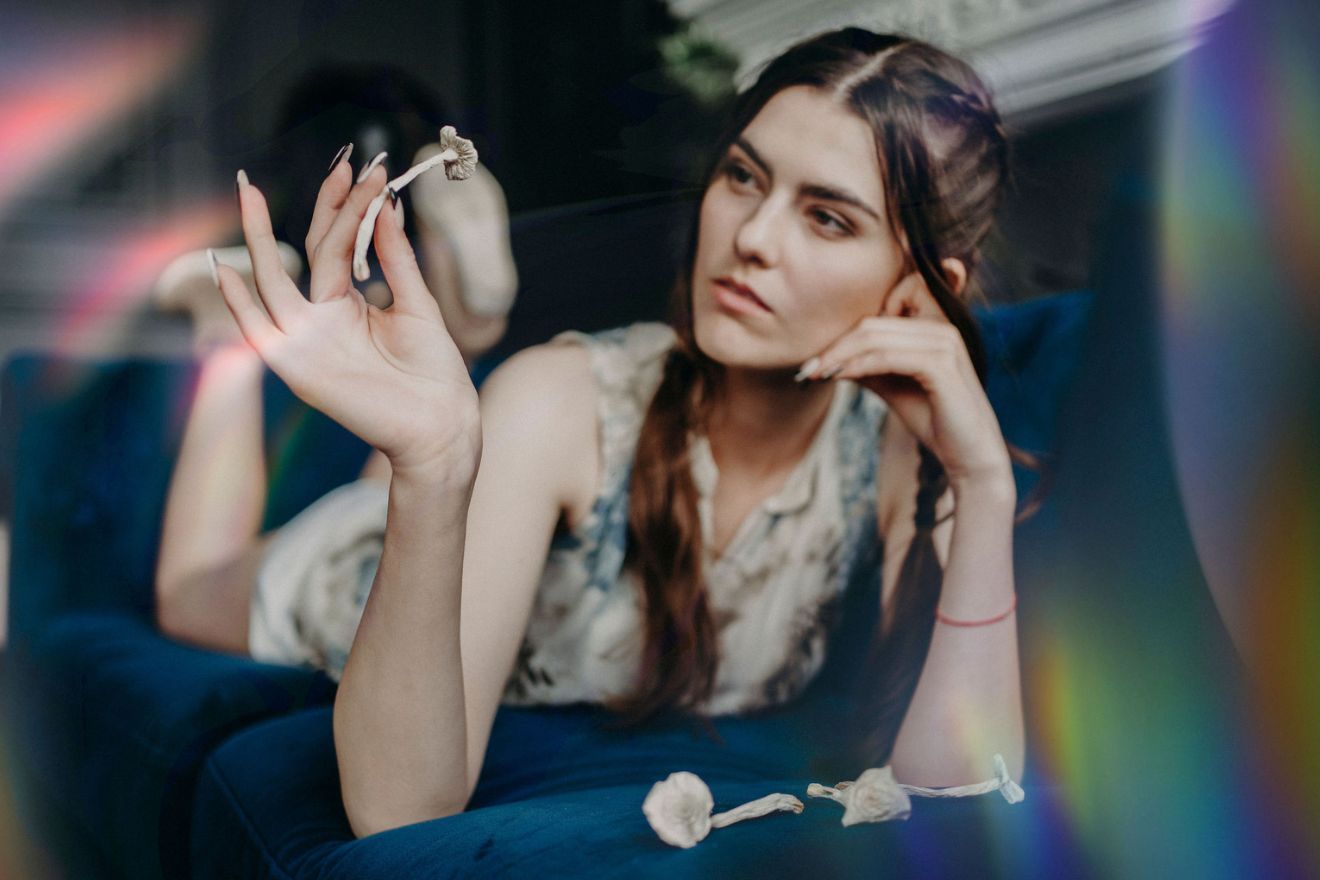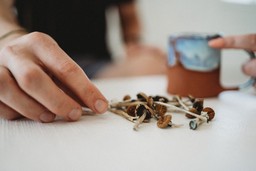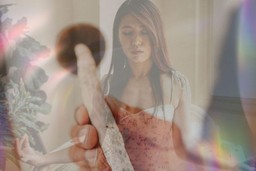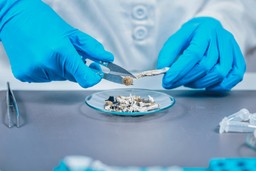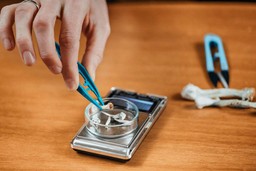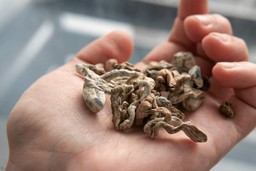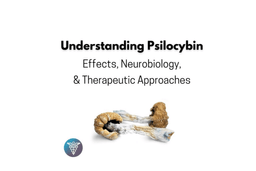This article is part of our article collection, “Unlocking the Magic: A Comprehensive Guide to Safe and Responsible Psilocybin Exploration.” Find the full collection here.
In this article, we review basic harm reduction principles and guidelines for safely consuming magic shrooms. This is perfect for both first-timers and experienced psychonauts.
What are Magic Mushrooms?
Magic mushrooms, also known as psilocybin mushrooms, are fungi consumed for their psychedelic effects. The primary ingredient in these mushrooms that makes them magic is the compound psilocybin. When consumed, psilocybin is rapidly metabolized into psilocin which is the molecule that reaches the brain and induces the psychedelic mushroom experience, often referred to as a journey or trip.
Researchers have discovered over 200 different species of psilocybin mushrooms, each with numerous strains [1]. Differences exist between mushroom species and their subsequent strains, paralleling the variations found within cannabis strains. Different species and strains contain varying concentrations of psilocybin and reportedly have variations in the psychedelic effects a person experiences.
Delve into The Wonderful and Diverse World of Psilocybin Mushroom Strains.
Some common magic mushroom strains are:
- Psilocybe cubensis (many types)
- Golden Teacher
- Albino Goldies
- Penis Envy
- Stargazer
- Liberty Caps
History of Magic Mushrooms
Magic mushrooms have been consumed for thousands of years by indigenous people worldwide for medicinal and ceremonial use [2]. Historians discovered North African and European cave paintings from 9,000 BC depicting mushrooms. In Northern Australia, rocks etched with mushroom imagery date to 10,000 BC. The ancient Greeks consumed mushrooms in ritual ceremonies, and numerous Egyptian artworks depict mushrooms which they called “food of the gods.”
Research into the therapeutic use of psilocybin began again in the 1990s after initial studies in the 1950s-60s were halted. In 2018-2019 the FDA granted Breakthrough Therapy status for psilocybin to treat major depressive disorder and treatment-resistant depression. Now clinical trials are investigating psilocybin to treat alcohol use disorder, depression, anxiety, headaches, and Parkinson’s Disease. Psilocybin is projected to become FDA-approved for depression in 2026 or 2027.
Preparing Magic Mushrooms for Consumption
People generally consume psilocybin mushrooms in dried form. Due to their strong flavor, some prefer to grind their mushrooms and consume capsules, while others may brew a tea or make an edible. Each method of preparation and consumption creates a slightly different effect and has varying onset timelines.
What are the Effects of Magic Mushrooms?
Psilocybin affects different people in slightly different ways, but there are common themes in a psychedelic mushroom journey, such as shifts in perception, heightened emotions, and a distortion of one’s sense of time. Many people who consume psilocybin mushrooms report feeling more connected and aware of their feelings and emotions, while some report having mystical experiences. It is not uncommon to feel wonder, awe, immense gratitude, or feelings of calm non-attachment.
Visual distortions and hallucinations are common and may include light halos, geometric patterns, distorted vision and audio, movement of objects, such as trees that appear to breathe, amplified colors, and rich closed-eye visuals, like watching a movie with some incredible special effects. Overall, the psilocybin experience can range from being extremely positive to incredibly challenging. Post-trip reports often describe feeling connected with the universe, the infinite, and God [3].
How to Safely Consume Magic Mushrooms
The guidelines below are based on basic harm reduction principles. Harm reduction refers to strategies and principles for substance use that neither encourage nor discourage recreational or intentional consumption but instead seek to minimize the negative consequences of using these substances.
It is just as it sounds – harm reduction aims for consumers to avoid harm and employ common sense. Harm reduction presents a non-judgmental approach to people who choose to consume psychoactive substances
Below are simple guidelines to consider for safety when consuming magic mushrooms.
Follow your Curiosity
Sign up to receive our free psychedelic courses, 45 page eBook, and special offers delivered to your inbox.What Shrooms Are You Consuming?
Unless a laboratory tests your mushrooms or you grow your own, it may be challenging to know what type of mushrooms you are consuming. Knowing the strain of the mushroom can help you gauge how potent the shrooms may be. For instance, P. azurescens tends to be more powerful than other strains, such as the common P. cubensis.
Knowing where your mushrooms were grown can also give you an indication of potency. Indoor-grown mushrooms boost the potency. Wild psilocybin mushrooms are exposed to UV radiation, which can diminish potency. Mushrooms lose potency over time, and the storage method can accelerate this. For example, light and heat exposure will decrease potency more rapidly than if stored in the dark. Generally speaking, when stored in a cool, dry space at room temperature, psilocybin mushrooms begin to lose their potency after approximately 12-18 months.
Find out How to Store Magic Mushrooms and Psilocybin Products.
Consider the Set and Setting
Set and setting affect how you will experience your mushroom journey. Set refers to your mindset entering into the experience, and setting refers to the physical and social environment. The term set and setting was coined by Harvard researcher Timothy Leary, the infamous Harvard professor psychonaut. His research showed that the set and setting influence the outcomes of people ingesting psychedelics [4].
Entering into your psychedelic experience with a positive mindset increases the likelihood of a smooth journey. Setting intentions and managing expectations, on the other hand, also positively impact the psychedelic experience. Asking yourself questions and challenging yourself on things you’d like to improve in your life is a great place to start.
Your job is to ensure you are in a safe environment so you can fully surrender to the mushroom and let it show you what you need to learn to optimize your psychedelic mushroom experience. Practices like meditation, mindfulness, breath work, and being in nature all provide helpful techniques that relax the body and quiet the mind, allowing the medicine to do its work.
For the setting or the environment and surroundings for your journey, find a comfortable and familiar space. See that the rooms are clean and uncluttered and that you have somewhere to lie down if necessary. Some people enjoy being in nature during their trip, but this may produce anxiety for others.
Clear your schedule, and even if you have experience with psilocybin mushrooms, it’s a good idea to consider having a ‘trip sitter’ with you as you explore the mushroom consciousness. This person can be a friend, family member, or a paid professional guide or sitter to ensure you have the safest and most beneficial experience possible. Ideally, this person should have experience with mushrooms and will be better equipped to handle things that might come up during your journey.
Start at an Appropriate Psilocybin Dose
A typical perceptual dose of psilocybin is anywhere from one to five grams of dried mushrooms. One gram is considered a low dose; however, it still produces noticeable effects. Ingesting five grams of mushrooms is a significant or “heroic dose,” a term coined by Terence McKenna. Again, It’s important to note that the psilocybin levels within mushrooms vary from strain to strain and with each harvest.
Read about How to Dose Magic Mushrooms here.
Unless you are in a clinical setting or a psychedelic clinical trial, you will most likely be guessing how much psilocybin is in your mushrooms. If it’s your first go-around with a batch of mushrooms, remember each batch can have varying amounts of psilocybin. For this reason, as the saying goes, “go low and slow” with your dose and start with one gram or less. You’ll need to have a digital scale to have accuracy with the weight. Write down the time you take your first dose because psilocybin is known to alter time perception.
Wait until the onset of your psychedelic experience to get a sense of how intense (or mild) your trip may be before ingesting more, and if you want to go deeper, you can ingest more than 60-90 minutes after the first dose. If you have eaten within a few hours before dosing, food can slow the onset of effects. This is why some people choose to fast for 4-12 hours before taking psilocybin mushrooms.
The intensity tends to wane after the first two hours, but the journey can last three to seven hours. No two mushroom journeys are ever the same, and duration can vary greatly.
Shrooms and Other Medication or Drugs
Mixing psilocybin with other drugs can increase or decrease the intensity of the experience and may have unintended consequences. The effects may be adverse as some medicines may not mix well with your mushrooms (see our webinar on drug-drug interactions). In addition, psilocybin works on our serotonin system, so it works on the same receptors as antidepressants, which can severely blunt the effects of the mushrooms. Talk to your doctor about any medications you’re taking and how to safely titrate off of them in order to have a meaningful and safe experience.
Ideally, alcohol should be abstained from for a minimum of a week prior to taking your magic mushrooms, and you should stay off it for a week or so afterward in order to optimize the beginning of the integration process. Drinking alcohol while on shrooms is not advised. It may lead to making poor choices that put yourself and others at risk for accidents or other uncomfortable situations.
Combining MDMA with psilocybin mushrooms, known as “hippie-flipping”, may increase known side effects of both substances and though not common, could potentially cause serious complications from too much serotonin released in the brain (called serotonin syndrome). Abstaining from MDMA for at least a month prior to psilocybin use will ensure the full desired effects of psilocybin are reached.
Your magic mushroom experience should be approached seriously. By being respectful to the medicine, having intentions, paying attention to set and setting, and not mixing drugs or alcohol, one greatly reduces the risk of adverse effects.
Read about the importance of Setting Intentions for Psychedelic Journeys.
Have a Plan for a Challenging Experience
If you or a friend start to have a challenging experience, there are a number of techniques you can apply that will get you back on track. The most common form of getting centered and grounded is to focus your attention on your breathing. Taking long, slow breaths in through the nose, then longer, slower breaths out through the mouth is an excellent relaxation technique that enables you to breathe into the effects of the mushrooms, allowing your mind and body to relax into the non-ordinary state of consciousness.
Soft, instrumental music can also be helpful, as can pulling your awareness into a body scan meditation. Connecting relaxing awareness to your body allows you to ground into the moment and surrender to the fungi. It may help to switch up your environment by going inside if you are outside or moving to a different room. If you’re having a particularly challenging experience, talk to a friend or your trip sitter, and if there’s no one around to talk to, you can call Fireside Project, a psychedelic peer support line. It’s free to call or text, and a volunteer will talk to you about your experience in real-time. If you need support after the journey, we have experienced psychedelic therapists at Psychedelic Support. You can schedule a session to decompress and make sense of whatever unfolded during your journey.
Integration is Key for Lasting Benefits
We can’t stress enough how important the integration process is after your journey has ended. If you want lasting benefits from your mushroom experience, whether for mental health or self-actualization, you need to unpack the insights bestowed and take action to make the necessary changes in your life. This is often hard work! But keep in mind that the neuroplastic effects of psilocybin are most prominent in the days and weeks after the journey. Try to use this window of time to start a new practice or change a habit.
Learn More About Psilocybin and Safety
Psychedelic Support offers a free harm reduction course with more tips on how to stay safe and prepare for your journey. We also have a 9-hour online psilocybin course for more advanced learning.
FREE Course | Riding the Wave: Principles in Psychedelic Harm Reduction
This free course includes 7 components: the introduction, harm reduction history and major players, principles, and frameworks of harm reduction, risks and potential adverse consequences of psychedelic use, harm reduction strategies, harm reduction for clinicians, and resources and additional information.
Understanding Psilocybin: Effects, Neurobiology, and Therapeutic Approaches
This course is perfect for health professionals, guides, or researchers interested in gaining insight into the science and therapies behind psilocybin (or magic mushrooms), a plant-based medicine used to treat mental health conditions.
This online course provides a comprehensive summary of the pharmacology and effects of psilocybin, how it works in the brain, and why people can have mystical experiences and sensory-perceptual shifts. Become knowledgeable on clinical protocols, safety and efficacy results, study participant accounts, and potential risks in both medical and non-medical settings.
- 9 hours of educational content (anyone can take the course)
- CE Certificate for licensed professionals, including psychologists, therapists, social workers, etc.
- CME Certificate (AMA PRA Category 1 Credit™) for doctors, nurses, medical professionals, etc.
Sign Up for the Psilocybin Course.
Follow your Curiosity
Sign up to receive our free psychedelic courses, 45 page eBook, and special offers delivered to your inbox.References
- Stamets, P. (1996). Psilocybin mushrooms of the world: an identification guide. Ten Speed Press.
- Matsushima, Y., Eguchi, F., Kikukawa, T., & Matsuda, T. (2009). Historical overview of psychoactive mushrooms. Inflammation and Regeneration, 29(1), 47-58. https://doi.org/10.2492/inflammregen.29.47
- Griffiths, R. R., Hurwitz, E. S., Davis, A. K., Johnson, M. W., & Jesse, R. (2019). Survey of subjective” God encounter experiences”: Comparisons among naturally occurring experiences and those occasioned by the classic psychedelics psilocybin, LSD, ayahuasca, or DMT. PloS one, 14(4), e0214377. doi: 10.1371/journal.pone.0214377
- Hartogsohn, I. (2017). Constructing drug effects: A history of set and setting. Drug Science, Policy and Law, 3, 2050324516683325. https://doi.org/10.1177/2050324516683325
